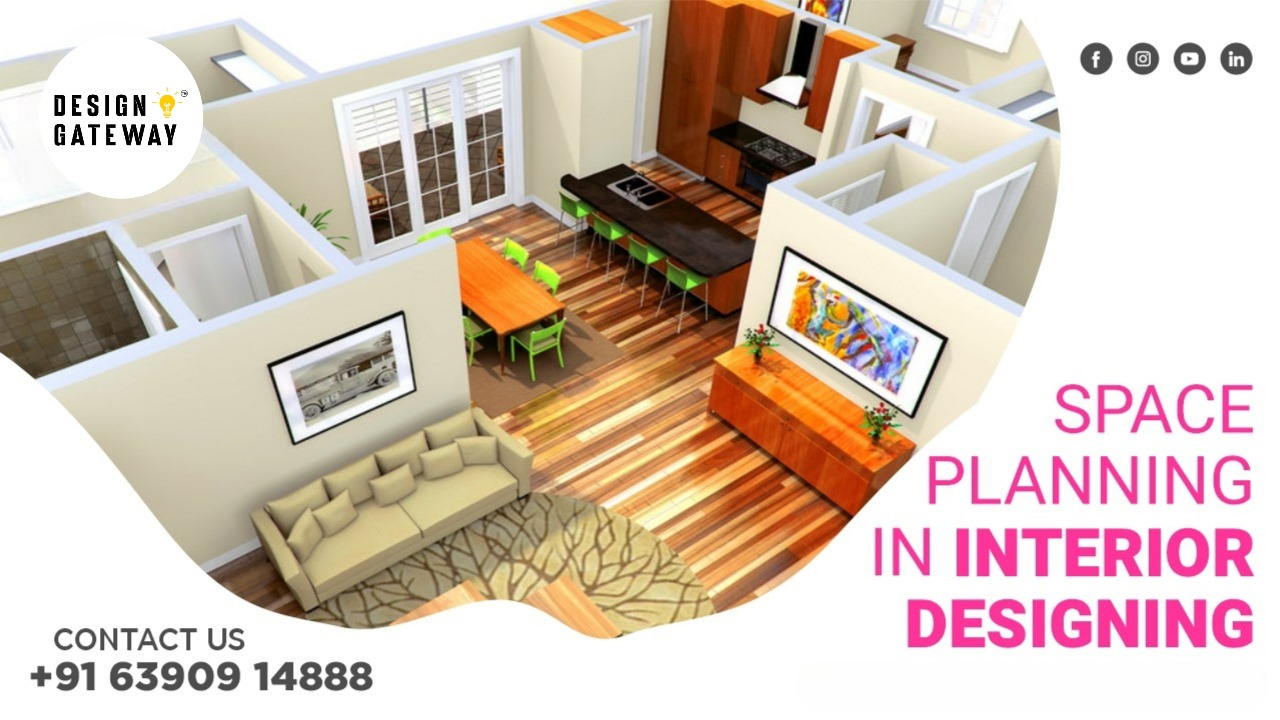What Exactly is Space Planning?
Space planning is an essential element in the interior design process. It begins with a thorough analysis of how to use the space plan. The whole designer then creates a plan that states how the different zones of the space are used. If you are a newbie, you should take interior designing training in Lucknow.
The space plan will also help you define the different circulation patterns that let people move about the space. The whole plan is then finished by adding other things to the furniture and other equipment.
Different Things to Consider When You Want to Layout Your Room
1. When you enroll in our interior designing course, you might want to learn about the room structure and the main focal points of these rooms, like windows, fireplaces and doors. Are they all balanced out properly? If not, try to add other things to the space to balance the structure out properly. Make sure to note that the human eye is focusing on focal points, and the space will be scanned when you enter the focal point.
2. Space perception is also based on different body sizes. Different spaces with different size spaces will suit different people. Someone’s nest might be another person’s nightmare. Here we also have Tarang Singhal view’s of what a good space plan should look like.
3. Think about the space parts in terms of their volume, and treat it like a fishbowl. How would the outcome be if you added some sofa in the space, a lovely chandelier, bookshelves, and a coffee table? Don’t overfill the whole space.
4. Objective To make a prospect and another refuge in the room so that the person can feel enclosed, but there is also a view outside the natural world. Use the correct theory to make your space more comfortable for a better human experience.
5. Do some furniture plan with a proper scale drawing of the room, cut down paper shapes to different sizes, and put them in the room to figure out the best arrangement for furniture and other accessories.
6. Ensure that the whole circulation passageway via the room will have an easy and economical pathway from the start of the door to other areas.
7. Clutter cut down the space, so remember to declutter and not block out circulation and reduce how big the room looks. At Dream Zone Lucknow, we offer suitable interior design courses to become a good space planner.
8. Whether there is a big or small space, subdivide different activity zones to define different parts of the room properly.
9. When planning for decoration and lightings, please work with the correct principles that different vertical lines attract our eyes up and draw some horizontal lines right across the plan and extend the room’s proportions.
10. Wallpaper that comes with a square grid or room tiling a room in different squares will give people the impression that the whole room looks more significant. If the grid is smaller, the larger the room will look.
11. Borrow some space from the “outside” by ensuring a continuous view of the outer world. You can also borrow space from different floors by connecting floors with proper materials.
12. When you refurbish small rooms, make sure to blur out the room edges to break up all different lines between the room and walks, and put the furniture away from these walls, and buy furniture that is in the proportion of the room, and pick the right furniture with legs to make sure that there is an illusion of extra space. Dream Zone Hazrtaganj will offer you the best courses in interior designing. Making sure that we are the top tuition service providers will ensure that you will get the best courses from us.

What are the Best Processes for Space Planning?
As we offer the best interior designing training courses, we ensure that you will be the best interior designer after you graduate from us. In general, you might want to think about space planning and make the right decisions when considering the person’s needs, different principles and the interior design that you have in mind.
The first thing you can use as a floor map is to designate the floor zones with different uses properly. The different conceptual uses are based on four different categories. It means that these conceptual decisions are either high-level or have a special dedication for specific work purposes. The whole thing will depend on the interior designer himself.
Next, go from the conceptual to floor plan decisions about different layouts and design aspects. Once you have decided where the social space should be, you can decide if the area is adjacent to another private part, or it will bring you to another social area like the dining room or the kitchen. These different decisions will also affect how clients entertain their guests and how comfortable they feel in their apartments.
Extra decisions can also be created from different level designations by showing off how the room might break into different decisions. For example, why does the workspace have to be fully functional? The client might also need desks, storage, etc.
Once different requirements are made, and there have been better refinements, you can make proper decisions on meeting these requirements. If you can determine how much storage you need, now it is time to offer different suggestions on how it should look. Do you want a bookshelf or a locked-up filing cabinet?
The whole process from conceptual to the final plan will help you fully understand what clients are searching for without asking any of the clients to commit to any design right from the start. It will give them the proper flexibility they require before making their final decision. The final decision is always rather crucial for the client.
Final Verdict
Are you looking for an interior design training school? Under a tight budget? Enroll in our classes at Lucknow today! We make sure that you get the best interior designing classes!




